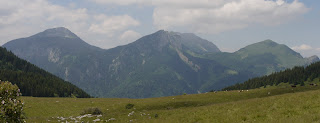Highworth Market Place
I was in the area on business and decided to do a walk I had previously noticed on the Walkingworld website. It starts from the charming Market Place of Highworth, a quiet town with a Georgian ambiance.
I had a look at the 13th century St Michael's church, tucked away in a cathedral-like close to one side of the High St.
From here the route continued along the High Street, past the leisure centre and through a golf course to finally escape the town. I chap I chatted to on the golf course mentioned that it was a fine place to spot Green Woodpeckers, but I failed to - we did see one in the garden recently however, which was a first.
The route now continued across fields over Red Down and passes a derelict wind pump, which acts as a useful landmark. You soon pass the site of what was clearly once a substantial deer farm. Now there are just some caged areas and a few desultory horses grazing. Why would a deer farm go bust? Too many wild ones available to be shot?
Now you reach the quiet village of Stanton Fitzwarren, a pleasant village with a handsome and, unusually, un-restored barn in the centre.
I made a short detour to see the church of St Leonard. Of Norman origin, it has been subject to the usual Victorian restoration. The tower however dates from 1631.
You leave the village and cross fields to reach the busy A361. Over the road a track leads to Queenlaines Farm which looked rather abandoned as I approached it. The farm buildings seem however to have been adapted for use as a school.
Soon afterwards you join the minor road which leads to Severnhampton, famous as the home and later burial place of Ian Fleming. This road offers nice views over the fields towards the Ridgeway.
On entering Severnhampton, the route veers immediately away to the left, past a cricket pitch. The sight screens, nets, pavilion and score box were all in pretty poor shape, although the grass seemed to have been cut recently.
Now there was another golf course to negotiate - whoopee - followed by a field path past a derelict-looking farm house and a school playing field to return to Highworth.
Conditions: sunny and warm.
Distance: about 6 miles.
From: walkingworld.com [ID 235]
Map: Explorer 169 (Cirencester and Swindon)and 170 (Abingdon, Wantage and Vale of White Horse).










 ,
,














